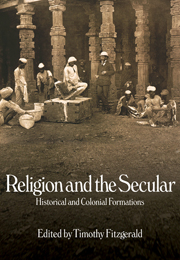Book contents
- Frontmatter
- Dedication
- Contents
- Acknowledgements
- Contributors
- Introduction
- 1 Dialectics of conversion: Las Casas and Maya colonial Congregación
- 2 A higher ground: the secular knowledge of objects of religious devotion
- 3 Secularizing the land: the impact of the Alaskan Native Claims Settlement Act on indigenous understandings of land
- 4 The formative process of State Shinto in relation to the Westernization of Japan: the concept of ‘religion’ and ‘Shinto’
- 5 Religious and secular in the Vietnam War: the emergence of highland ethno-nationalism
- 6 Colonialism all the way down? Religion and the secular in early modern writing on south India
- 7 Understanding politics through performance in colonial and postcolonial India
- 8 Real and imagined: imperial inventions of religion in colonial southern Africa
- 9 Religion in modern Islamic thought and practice
- 10 Rudolf Otto, cultural colonialism and the ‘discovery’ of the holy
- 11 Encompassing Religion, privatized religions and the invention of modern politics
- 12 Colonialism and the myth of religious violence
- Index
5 - Religious and secular in the Vietnam War: the emergence of highland ethno-nationalism
- Frontmatter
- Dedication
- Contents
- Acknowledgements
- Contributors
- Introduction
- 1 Dialectics of conversion: Las Casas and Maya colonial Congregación
- 2 A higher ground: the secular knowledge of objects of religious devotion
- 3 Secularizing the land: the impact of the Alaskan Native Claims Settlement Act on indigenous understandings of land
- 4 The formative process of State Shinto in relation to the Westernization of Japan: the concept of ‘religion’ and ‘Shinto’
- 5 Religious and secular in the Vietnam War: the emergence of highland ethno-nationalism
- 6 Colonialism all the way down? Religion and the secular in early modern writing on south India
- 7 Understanding politics through performance in colonial and postcolonial India
- 8 Real and imagined: imperial inventions of religion in colonial southern Africa
- 9 Religion in modern Islamic thought and practice
- 10 Rudolf Otto, cultural colonialism and the ‘discovery’ of the holy
- 11 Encompassing Religion, privatized religions and the invention of modern politics
- 12 Colonialism and the myth of religious violence
- Index
Summary
The people living in the central highlands of southern Vietnam spoke dozens of languages, had no political or social organization above the level of the village, and no sense of themselves as ‘a people’ until French colonial administrators began to arrive in force in the early twentieth century. French imperial policy gathered the disparate highlanders under the label “Montagnard” (French for “mountain people” or “highlander”) and began codifying the differences between the highland “savages” and the lowland Vietnamese people (considered ‘civilized’ in the orbit of the great Chinese tradition). French ethnographies contrasted the densely populated Vietnamese society (described as based on wet rice paddy cultivation, a Confucian social system and rich Buddhist monasteries) to what they characterized as the Montagnards’ “primitive” swidden agriculture, “isolated” and “crude” villages, and no written language. The image of highland men in loincloths and women dressed in wraparound skirts, naked above the waist, only reinforced the clarity of the French classification system that placed the highland people as “proto-indochinese”-primitives living naturally off the rich plant and animal resources of the jungle.
The category of ‘religion’ was central to French ethnographic analysis of Montagnard culture. Highlanders often spoke of yang (translated into French as “spirits”) that resided in distinctive natural landmarks, powerful animals and the forces of nature. Highlanders said that yang control people's fate and influence human and natural events. They referenced yang in their consumption of rice and rice wine, and the ceremonial killing of chickens, pigs and water buffalo.
- Type
- Chapter
- Information
- Religion and the SecularHistorical and Colonial Formations, pp. 103 - 116Publisher: Acumen PublishingPrint publication year: 2007



